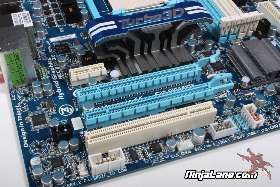After careful consideration I have decided to transfer all hardware review activities to a new domain. I purchased Hardwareasylum.com in 2012 and have been working hard to build a new and improved Ninjalane on that domain. If you are reading this you have reached one of the archived articles, news, projects and/or reviews that were left behind during the site migration.
Please update your bookmarks and be sure to visit the new and improved Ninjalane at Hardwareasylum.com
Gigabyte GA-880GMA-UD2H Motherboard Review
Author: Dennis Garcia
Published: Wednesday, November 03, 2010
Board Layout and Features
Overall board layout does not differ much from a typical MicroATX motherboard, in fact the layout mimics that of a full sized motherboard minus 3 expansion slots.
The back of the board is extremely clean and features a black metal reinforcement plate designed to keep the motherboard from flexing after the heatsink has been installed. As with most AMD systems this bracket is removable to make room for larger aftermarket heatsinks and waterblocks.
The onboard power supply is a 4+1 design that Gigabyte calls a "Split Power Plane VRM". 4 power phases are dedicated to the CPU with the remaining phase typically allotted to the MCP.
The onboard power supply is a 4+1 design that Gigabyte calls a "Split Power Plane VRM". 4 power phases are dedicated to the CPU with the remaining phase typically allotted to the MCP.
AMD3 Phenom II and Athlon II processors are supported including all current 45nm 4core Deneb and 6core Thuban CPUs. While not officially documented we estimate the maximum CPU draw to be around 140w given the 4+1 VRM and lack of mosfet cooling solution. Actual power draw can vary depending on what processor you go with so exercise caution if you choose to overclock.
4x DDR3 memory slots are available supporting up to 16gb of memory. To get the best performance install your high speed modules (1800+) into the outer memory banks 3 and 4.
4x DDR3 memory slots are available supporting up to 16gb of memory. To get the best performance install your high speed modules (1800+) into the outer memory banks 3 and 4.
The expansion slot layout is very unique for a MicroATX design and features only a single legacy PCI slot. The remaining PCI Express slots are divided up with 1x, 16x and 4x lanes respectively. Dual physical 16x PCI Express slots allow for more than one graphics card to be installed, however since it shares bandwidth with the primary 16x slot the total bandwidth will be limited to 4 lanes each.







